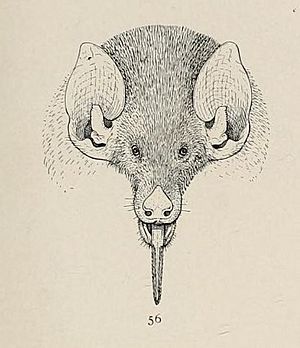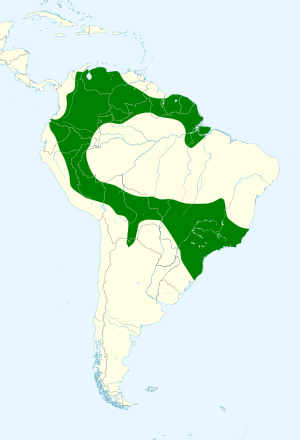Tailed tailless bat facts for kids
The tailed tailless bat (scientific name: Anoura caudifer) is a type of leaf-nosed bat that lives in South America. It's known for its interesting name, which hints at a small tail even though it belongs to a group often called "tailless bats."
Quick facts for kids Tailed tailless bat |
|
|---|---|
 |
|
| Conservation status | |
| Scientific classification | |
| Genus: |
Anoura
|
| Species: |
caudifer
|
 |
|
| Tailed tailless bat range | |
| Synonyms | |
|
Anoura caudifera |
|
Contents
What's in a Name?
The scientific name for this bat is A. caudifer. It was first described by a scientist named Étienne Geoffroy Saint-Hilaire in 1818.
This bat has a funny common name: the "tailed tailless bat." It's called this because it belongs to a group of bats known as "tailless bats" (genus Anoura). But guess what? This particular bat actually has a small tail! It's a bit confusing, but it makes the bat unique.
About the Tailed Tailless Bat
The tailed tailless bat is one of the smaller bat species. It measures about 4.7 to 7.0 centimeters (about 2 to 2.7 inches) long from head to body. It weighs only about 8.5 to 13 grams (less than half an ounce), which is super light!
Its body is covered in soft, dark-brown fur. Some bats might have lighter, reddish patches on their upper back and head. The parts of their wings without fur are dark brown or black.
Special Features
This bat has a long, narrow head and a very long tongue that can stretch up to 3 centimeters (about 1.2 inches). This long tongue helps it reach food. It also has a small, narrow nose-leaf on its upper lip. Its ears are fairly small and set far apart.
As its name suggests, the tailed tailless bat usually has a very short tail, only about 3 to 7 millimeters (less than half an inch) long. This tiny tail is hidden within the membrane between its legs. Some of these bats don't have a tail at all!
Where They Live
You can find the tailed tailless bat in many countries in South America. These include Bolivia, southern and northeastern Brazil, Colombia, Ecuador, French Guiana, Guyana, Peru, Suriname, Venezuela, and the very northern part of Argentina. They like to live in tropical forests on both sides of the Andes mountains, often at high elevations.
Life Cycle and Habits
Tailed tailless bats have a very fast metabolism, which means their bodies burn energy quickly. Because of this, they need to eat a lot of food for their size. They spend at least four hours every night looking for food.
Scientists are still learning about when these bats have their babies. They usually find adult bats ready to reproduce between August and November, which is during the rainy season. It's thought that these bats usually have only one baby at a time, once a year.
What They Do
The tailed tailless bat is nocturnal, meaning it is active at night. During the day, it rests in safe places like caves, hollow trees, or even some human-made buildings.
They often live in groups called colonies. These colonies can have up to 100 bats, but usually, they are smaller, with about 5 to 15 bats. Like many bats that live in caves, they often share their roosts with other types of bats, such as common big-eared bats and vampire bats.
These bats are omnivores, which means they eat both plants and animals. They use their long tongues to drink nectar from flowers. They also enjoy eating small insects like beetles, bugs, and moths.
See also
 In Spanish: Anoura caudifer para niños
In Spanish: Anoura caudifer para niños


